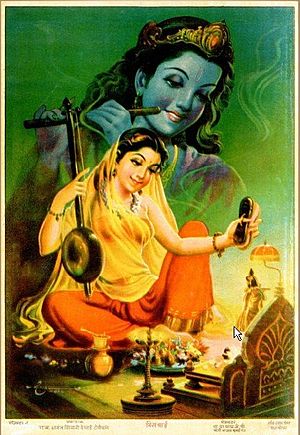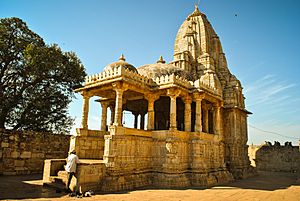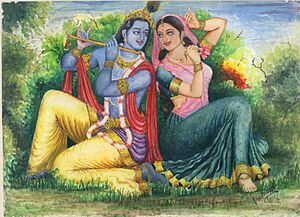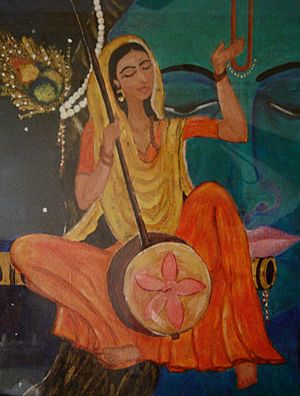Meera facts for kids
Quick facts for kids Meera |
|
|---|---|

Raja Ravi Varma's painting of Meera Bai
|
|
| Religion | Hinduism |
| Known for | Poet Bhakti movement, Vaishnavism (Lord Krishna) |
| Other names |
|
| Personal | |
| Born | c.1498 Kudki, Pali district, Jodhpur State, Rajasthan |
| Died | c.1546, Dwaraka, Sur Empire |
| Spouse | Bhojraj Singh Sisodia |
Meera, also known as Mirabai (मीराबाई; born around 1498, died around 1546), was a famous Hindu poet from the 16th century. She was a deeply spiritual person and a great follower of Lord Krishna. Her original name was 'Mihira', but she became known as Meera because of the way her name was said in Rajasthan.
Meera is a very important saint in the Bhakti movement, especially in North India. The Bhakti movement was a time when people showed their love for God through poems and songs. Meera was born into a royal family in Rajasthan. She spent her childhood in Merta. Many stories about Meera tell how she bravely ignored social rules and family traditions. She was completely devoted to Lord Krishna, treating him as her husband. Some stories say her family tried to stop her because of her strong religious beliefs.
Millions of devotional songs, called bhajans, are said to be written by Meera. These songs praise Lord Krishna and are very popular all over India. However, scholars believe only a few hundred of these songs were actually written by her. Many others were likely composed later by people who admired her. Temples, like one in Chittorgarh fort, are dedicated to her memory. Meera's life has also inspired movies and comic books in modern times.
Contents
Meera's Life Story

It's hard to find exact historical records about Meera's life. Scholars have tried to learn about her from other old writings. Meera unwillingly married Bhoj Raj, who was the prince of Mewar, in 1516. Her husband was hurt in a war in 1518 and sadly died from his injuries in 1521. Both her father and her father-in-law also died a few days after a big battle.
After her father-in-law passed away, Vikram Singh became the new ruler of Mewar. Many popular stories say that her new family tried to harm her. For example, they might have sent her a glass of poison, saying it was a special drink. Or they might have sent her a basket with a snake instead of flowers. But the legends say she was never hurt. The snake supposedly turned into a statue of Krishna or a garland of flowers. Another story says Vikram Singh told her to drown herself, but she floated on the water instead.
Some stories also say that the Mughal emperor Akbar the Great and his musician Tansen visited Meera. They supposedly gave her a pearl necklace. However, scholars doubt this happened because Tansen joined Akbar's court much later, after Meera had already passed away. Similarly, some stories say Guru Ravidas was her teacher, but there is no clear proof of this.
Older records from the 17th century don't mention much about her childhood or her marriage. They also don't say that her in-laws were the ones who troubled her. Some experts believe that any challenges Meera faced were more likely due to the political problems and wars between the Rajput kingdom and the Mughal Empire at that time.
Other stories say that Meera left the kingdom of Mewar and went on religious journeys. In her final years, Meera lived in Dwarka or Vrindavan. Legends say she mysteriously disappeared in 1547 by merging into a statue of Krishna. While these miracle stories are debated by scholars, it is widely agreed that Meera dedicated her life to Lord Krishna. She composed many devotional songs and was a very important poet-saint of the Bhakti movement.
Meera's Poems
Many of Meera Bai's songs are still sung in India today. They are mostly devotional songs called bhajans, and they often have a deeper, philosophical meaning. One of her most famous songs is "Paayoji maine Ram Ratan dhan paayo" (पायो जी मैंने राम रतन धन पायो।), which means "I have been given the richness of Lord Ram's blessing."
Meera's poems are lyrical padas, which are like metric verses. They are written in the Rajasthani language. While thousands of verses are said to be hers, scholars are not sure how many she actually wrote. There are no original handwritten copies of her poems from her own time. The earliest records with poems credited to her are from the early 18th century, more than 150 years after she died.
Poems in Hindi and Rajasthani
The largest collection of poems said to be hers are found in writings from the 19th century. Scholars try to figure out which poems are truly hers by looking at mentions of Meera in other old texts and by studying the style and language of the poems. It's sometimes hard to know for sure if the poems we read today were actually written by the historical Meera.
In her poems, Meera often sees Krishna as a spiritual guide and a lover. She sees herself as a devoted follower ready to join him in a spiritual union. Meera's writing style shows strong feelings like passion, defiance, longing, joy, and deep happiness. All these feelings are centered around her love for Krishna.
My Dark One has gone to an alien land.
He has left me behind, he's never returned, he's never sent me a single word.
So I've stripped off my ornaments, jewels and adornments, cut my hair from my head.
And put on holy garments, all on his account, seeking him in all four directions.
Mira: unless she meets the Dark One, her Lord, she doesn't even want to live.—Mira Bai, Translated by John Stratton Hawley
Meera often talks about her personal connection with Krishna. She calls him her lover, her lord, and the "mountain lifter" (referring to a story where Krishna lifted a mountain). Her poetry shows her complete surrender and devotion.
After making me fall for you so hard, where are you going?
Until the day I see you, no repose: my life, like a fish washed on shore, flails in agony.
For your sake I'll make myself a yogini, I'll hurl myself to death on the saw of Kashi.
Mira's Lord is the clever Mountain Lifter, and I am his, a slave to his lotus feet.—Mira Bai, Translated by John Stratton Hawley
Meera is often grouped with other northern Bhakti saints who spoke about Lord Sri Krishna.
Meera's Influence
Experts agree that Meera was one of the most important poet-saints of the Bhakti movement. This was a challenging time in Indian history with many religious conflicts. Meera's story became a symbol of people's struggles and their hope for a better way of life.
Meera's lasting influence comes from her message of freedom. She showed great determination and the right to follow her devotion to Krishna and her spiritual beliefs, even when she faced difficulties. Her appeal in Indian culture, according to Edwin Bryant, is that she appears as a person "who stands up for what is right and suffers bitterly for holding fast to her convictions." Yet, she does this with words of love, expressing all the different feelings that come with love, whether between people or between humans and God.
English Versions of Meera's Poems
Many of Meera's bhajans have been translated into English. Some well-known translations include those by Robert Bly and Jane Hirshfield in their book Mirabai: Ecstatic Poems.
Images for kids
See also
 In Spanish: Mirabai para niños
In Spanish: Mirabai para niños





